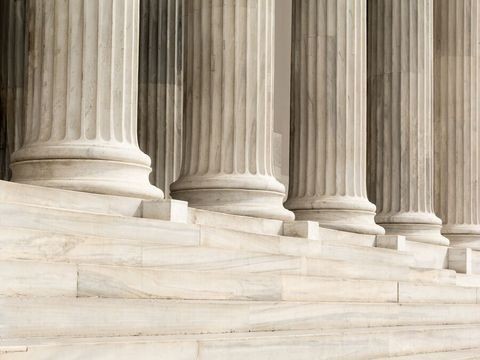Will the Supreme Court Address Whether the Ninth Circuit’s Server Test Comports With the Display Right Accorded Copyright Owners?
What You Need to Know
Key takeaway #1
Supreme Court asked to review the unique Server Test in the Ninth Circuit.
Client Alert | 2 min read | 04.17.25
Will the Supreme Court review the Ninth Circuit’s unique Server Test for online copyright infringement? After the Ninth Circuit recently affirmed the Server Test, a photographer and copyright owner has requested certiorari. Petitioner-Plaintiff, Elliot McGucken, is a landscape photographer. Respondent-Defendant, Valnet, Inc., is the owner of a travel website located at “www.thetravel.com.” McGucken sued Valnet for copyright infringement when Valnet embedded on its site a number of links to McGucken’s Instagram posts. The district court, bound by the Ninth Circuit’s en banc decision in Perfect 10, granted Defendant’s motion to dismiss, finding that the Server Test foreclosed McGucken’s direct infringement claim as a matter of law, because Valnet linked to the images and did not store them on its own servers. The Ninth Circuit affirmed in a panel decision. McGucken now requests the Supreme Court to review the validity of the Server Test, which is unique to the Ninth Circuit.
The Server Test, created by the Ninth Circuit in Perfect 10, Inc. v. Amazon.com, Inc., 508 F.3d 1146 (9th Cir. 2007), is unique. In Perfect 10, the Ninth Circuit found that if a website displays an image by using a copy of the image stored on the website owner’s own server, that is infringement. If, on the other hand, the same website shows the same image by merely “embedding” a link to the image, that does not violate the “public display” right protected by copyright law. The Ninth Circuit reasoned that because embedding is merely code that instructs the website to display an image on a third party’s server and the image is not fixed in the memory of the website operator’s computer, the website operator does not “display” the copyrighted image.
The Ninth Circuit stands alone in holding that images are not “displayed” within the meaning of the Copyright Act unless the website server hosts a copy of the infringing image. No other court of appeals opines on this issue, and multiple district courts outside the Ninth Circuit have explicitly refused to adopt the Server Test.
In the petition, McGucken argues that the Server Test runs afoul of the Copyright Act, as the Server Test artificially creates a prerequisite of possessing a copy of an infringing image before displaying, which does not appear in the statute or legislative history of the Copyright Act. He further argues, relying heavily on the Supreme Court’s holding in American Broadcasting Cos. v. Aereo, Inc., 573 U.S. 431 (2014), that this technological distinction of embedding a link is “invisible” to users and should not be considered in the copyright infringement analysis: “Whether a webpage displays photographs from the same or separate copies, it displays the work; it shows the same images to the same users via the same interface.”
Valnet filed a waiver of right to respond to the petition, and the petition has now been sent to the Justices’ chambers for their consideration at an upcoming conference on April 25, 2025.
Contacts
Insights
Client Alert | 5 min read | 12.12.25
Eleventh Circuit Hears Argument on False Claims Act Qui Tam Constitutionality
On the morning of December 12, 2025, the Eleventh Circuit heard argument in United States ex rel. Zafirov v. Florida Medical Associates, LLC, et al., No. 24-13581 (11th Cir. 2025). This case concerns the constitutionality of the False Claims Act (FCA) qui tam provisions and a groundbreaking September 2024 opinion in which the United States District Court for the Middle District of Florida held that the FCA’s qui tam provisions were unconstitutional under Article II. See United States ex rel. Zafirov v. Fla. Med. Assocs., LLC, 751 F. Supp. 3d 1293 (M.D. Fla. 2024). That decision, penned by District Judge Kathryn Kimball Mizelle, was the first success story for a legal theory that has been gaining steam ever since Justices Thomas, Barrett, and Kavanaugh indicated they would be willing to consider arguments about the constitutionality of the qui tam provisions in U.S. ex rel. Polansky v. Exec. Health Res., 599 U.S. 419 (2023). In her opinion, Judge Mizelle held (1) qui tam relators are officers of the U.S. who must be appointed under the Appointments Clause; and (2) historical practice treating qui tam and similar relators as less than “officers” for constitutional purposes was not enough to save the qui tam provisions from the fundamental Article II infirmity the court identified. That ruling was appealed and, after full briefing, including by the government and a bevy of amici, the litigants stepped up to the plate this morning for oral argument.
Client Alert | 8 min read | 12.11.25
Director Squires Revamps the Workings of the U.S. Patent Office
Client Alert | 8 min read | 12.10.25
Creativity You Can Use: CJEU Clarifies Copyright for Applied Art
Client Alert | 4 min read | 12.10.25
Federal Court Strikes Down Interior Order Suspending Wind Energy Development





